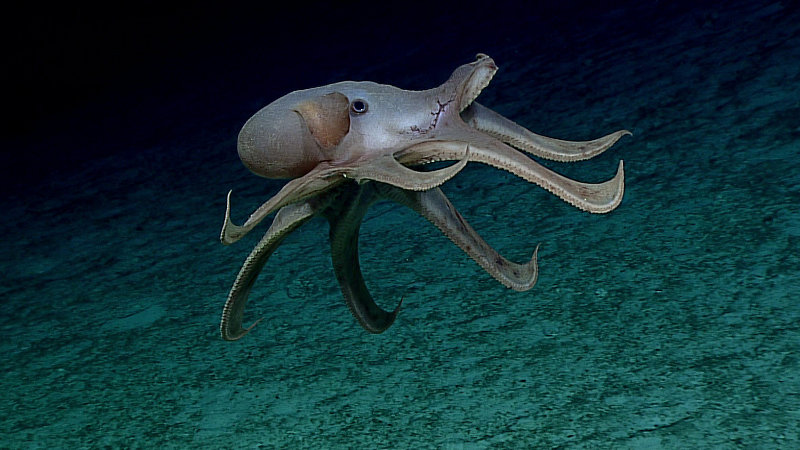- Home
- Expeditions
- Light and Life Below the Twilight Zone
- Background
- Cephalopods
Cephalopods are known for their amazing ability to camouflage and change their appearance quickly in the shallow ocean zones around the world. What do they do when there is no light available? The need to camouflage no longer exists, so what adaptations has this group of invertebrates developed?
Seventy of the approximately 90 cephalopod species found in the Gulf of Mexico are considered deep-sea animals, found in the water column down to the seafloor thousands of meters below. There are a variety of adaptations, from bioluminescence, transparency, and dark coloration, to gelatinous bodies that cephalopods employ to survive in the dark world below 1,000 meters (3,280 feet). Here are just a few examples:
- Cephalopods like the vampire squid (Vampyroteuthis infernalis) possess the ability to survive in the dark by matching the density of seawater to reduce their need for active swimming. Hanging suspended in the water column, vampires use their “filaments” (thin tentacle-like appendages) to trap marine snow and small organisms for their meals between 600-1,500 meters (1,970-4,920 feet) deep. They also have photophores on the head and body in order to match the dim light from the surface and thus protect themselves when predators are lurking. Photophores on their arm tips can create a dazzling display to distract predators.

The Vampire Squid, Vampyroteuthis infernalis. Image courtesy of Journey into Midnight: Light and Life Below the Twilight Zone/Ocean Exploration Trust. Download larger version (jpg, 132 KB).
- The whiplash squid (Mastigoteuthis agassizii) are more muscular and also inhabit the meso-and bathy pelagic zones as adults. They are known for their long tentacles with microscopic suckers and a large fin which helps them hover above the seafloor. These squid also have photophores covering parts of the body, embedded in the skin. As they grow, they move deeper into the water column (from 200-600 meters; 650-1,970 feet to 1,000-1,500 meters; 3,280-4,920feet) possibly to avoid being eaten by whales.

The whiplash squid, Mastigoteuthis agassizii. Image courtesy of Journey into Midnight: Light and Life Below the Twilight Zone. Download image (jpg, 59 KB).
- Two pelagic, gelatinous octopods also inhabit the zones below 1,000 meters (3,280 feet): Japetella diahana and Bolitaena pygmaea. These octopods also move deeper as they develop, spending much of their adult lives below 1,000 meters. An interesting fact about Bolitaena pygmaeais that females havea bioluminescent ring around their mouth, which is thought to help males find them for mating.
- The benthic octopods found deeper than 1,000 meters tend to have reduced ability to produce ink. For example, the dumbo octopus (Grimpoteuthis spp.) does not have an ink sac, which makes sense since they are always living in the dark. They also use their large fins for moving through the water. The dumbo octopus is one of the deepest-living octopus species-ithas been found 4,000 meters (13,120 feet) deep!



